Most people don’t realize just how common iron deficiency is, or how subtle its first signs can be. Recognizing the early signs of iron deficiency is key for staying healthy, as even mild shortages can slow you down and sap your energy. Iron supports nearly every cell in the body, helping to transport oxygen and keep your brain, muscles and metabolism running well.
If you catch symptoms early, it’s much easier to restore balance and prevent bigger health problems later. This post will help you spot early signs of iron deficiency, understand iron’s role in your well-being, and know when it’s time to talk to a healthcare provider. Your health—and your everyday energy—depend on it.
What is Iron Deficiency and Why is it Important?
Iron deficiency is more than just a number on your blood test. This common nutritional shortage means your body doesn’t have enough iron to support basic needs. Even a slight shortfall can start to mess with your energy, focus, and overall function, which is why spotting the early signs of iron deficiency matters for everyone.
Iron’s Role in the Body
Iron acts as the body’s oxygen delivery system. It helps build hemoglobin, a protein in your red blood cells, that shuttles oxygen from your lungs out to every tissue. When you’re low on iron, your cells struggle to get the oxygen they need—which is when the trouble starts.
Besides oxygen transport, iron supports:
- Muscle performance
- Brain function and memory
- Immune response
- Healthy skin, hair, and nails
Without enough iron, your body starts to cut corners. Everyday tasks, like going up stairs or concentrating at work, might suddenly feel harder. Even your hair and nails can take a hit—thinning hair or brittle nails can be linked to low iron, as explained in this article on the impact of diet on hair health.
Common Causes of Iron Deficiency
Iron deficiency isn’t rare. It can sneak up due to habits, life stages, or health issues. Here are a few reasons you might become low on iron:
- Low Iron Intake: Not eating enough iron-rich foods, especially from animal sources such as meat or seafood, or cutting out food groups altogether.
- Poor Absorption: Gut conditions (like celiac disease) or surgeries can keep you from soaking up the iron in your meals.
- Blood Loss: Heavy periods, pregnancy, frequent blood donation, or internal bleeding (from ulcers or digestion issues) can drain your iron stores.
- Increased Need: Children, teens, and women (especially while pregnant or breastfeeding) need extra iron to grow and stay healthy.
Everyday life, changes in your diet, or health shifts can put you at risk, even if you feel fine today.
Who is Most at Risk?
Almost anyone could develop iron deficiency, but a few groups need to stay even more alert to early signs of iron deficiency:
- Women of childbearing age: Menstruation increases the risk, especially with heavy periods or pregnancy.
- Children and teens: Rapid growth demands more iron than usual.
- Vegetarians and vegans: Plant-based iron isn’t absorbed as well as the type found in animal products.
- Older adults: Medical issues and changes in diet can make it harder to keep iron levels steady.
- People with chronic illnesses or digestive disorders: Conditions like Crohn’s or celiac disease hinder absorption.
Health Risks When Iron Deficiency Goes Unchecked
If early signs of iron deficiency are missed, problems don’t stop at tiredness or pale skin. Over time, low iron can lead to anemia—when your blood can’t carry enough oxygen. Untreated, this can cause:
- Weakness and exhaustion
- Shortness of breath
- Rapid heartbeat or heart palpitations
- Trouble with memory or focus
Severe cases may even affect heart health or immune response. That’s why it’s smart to consider your daily habits, and even think about your diet’s nutritional value of iron-rich foods as part of your routine. Catching issues early gives you the best chance at staying energized and well.
Early Signs of Iron Deficiency to Watch For
Noticing the early signs of iron deficiency can make a real difference in how you feel every day. Sometimes these changes sneak up on you, showing up as small issues you might brush off as just being stressed or tired. Let’s break down the most common early symptoms and what they can signal about your health.
Unexplained Fatigue and Weakness
Feeling drained for no clear reason is often one of the first signs your body isn’t getting enough iron. Even after a full night’s sleep, you might wake up feeling as if you hardly rested at all. Everyday tasks like walking the dog or carrying groceries can leave you unusually tired.
Iron is essential for making hemoglobin, which brings oxygen to your muscles and organs. When your iron levels dip, your muscles struggle to get enough oxygen. This lack leads not only to tiredness but also to muscle weakness. If you find yourself losing stamina or feeling winded during activities that used to be easy, it may be time to check your iron status.
Key warning signs include:
- Feeling tired all the time, even with enough rest
- Needing longer recovery after exercise or simple chores
- Easily losing strength or endurance
Changes in Skin and Hair
Your skin and hair can give early clues that your body is running low on iron. One of the most noticeable early signs of iron deficiency is pale or sallow skin. When there’s less hemoglobin, there’s less red in your complexion, so your face may look washed out or have a yellowish tint.
Brittle or spoon-shaped nails and thinning hair often follow. If you’re seeing more hair in your brush or your ponytail feels lighter, your body might be redirecting resources away from your scalp to support more urgent needs. For tips on giving your hair its best chance, check out these innovative, natural and effective hair follicle detox formula.
Other symptoms to notice:
- Nails that break, split, or have strange shapes
- Hair that seems thinner or falls out more easily
- Dry or itchy skin that doesn’t improve with lotion
Shortness of Breath and Heart Palpitations
Not getting enough oxygen to your tissues can cause odd symptoms even if you’re at rest. Shortness of breath is a common early sign of iron deficiency. Climbing stairs or walking quickly could leave you gasping, when it never used to bother you before.
As your body tries to adapt, your heart may start working harder to deliver oxygen, causing you to notice an irregular or pounding heartbeat, especially during exercise. These palpitations can feel like flutters, skipped beats, or even a racing heart.
Common signs might include:
- Struggling to catch your breath with light exercise
- Feeling your heart pounding or skipping beats
- Dizziness or a spinning sensation, especially when standing up fast
Unusual Cravings and Cognitive Changes
Iron plays an important role in brain function. When your levels run low, you might notice it in your mind and your cravings. One very unusual but telling sign is pica, the urge to eat non-food items like ice, clay, chalk, or even paper. While these cravings may seem strange, they can be your body’s way of asking for nutrients.
At the same time, you may feel foggy-headed, have trouble focusing, or get irritable more easily. Kids may struggle at school, and adults might find it hard to be productive at work.
Key changes to watch for:
- Craving ice, dirt, or other non-edibles
- Trouble paying attention or forgetfulness
- Mood swings or feeling down for no clear reason
Spotting these early signs of iron deficiency is more than just checking off a list of symptoms. It’s about listening to the subtle messages your body sends before more serious anemia develops. If any of these symptoms sound familiar, it might be time to evaluate your diet and talk to a healthcare professional about how to boost your iron and reclaim your energy.
When and How to Seek Medical Advice
Early signs of iron deficiency can sneak up on you, but knowing when to bring your concerns to a healthcare provider can make a big difference. Ignoring symptoms often leads to more problems later, so it pays to listen to your body and reach out for help when things don’t feel right. If you notice unusual fatigue, frequent shortness of breath, or changes in your skin and hair, it might be time to act.
When to See a Healthcare Provider
Don’t wait until the symptoms get severe. If you experience any of the following, talking to a doctor is important:
- You feel tired most days, even after quality sleep.
- You notice unusual hair loss, brittle nails, or pale skin.
- Exercise leaves you panting or dizzy, even though it didn’t before.
- You develop cravings for non-food items such as ice or clay.
- Symptoms persist, worsen, or start affecting your daily life.
Trust your gut. If something feels off, it’s better to ask than to wait and hope it improves. While it’s common to brush off mild symptoms, getting medical advice early can help you avoid much tougher health challenges down the road. This is the same approach suggested when handling persistent headache symptoms, as you’ll find in these tips to get rid of tension headaches.
What to Expect at the Doctor’s Office
Worried about what happens during a visit? Your provider won’t just check iron levels on a whim—there’s a process to get a clear picture of what’s going on.
Most doctors start with a physical exam and a conversation about your symptoms, diet, lifestyle, and family history. They’ll probably ask about changes in your energy, appetite, or periods (for women). These details help them decide whether iron deficiency could be the cause.
After the chat, simple blood tests usually come next. The most common ones include:
- Complete Blood Count (CBC): Measures overall health and detects anemia.
- Serum Ferritin: Shows how much iron your body has stored.
- Serum Iron and Total Iron-Binding Capacity (TIBC): Evaluate how much iron is in your blood and how well it’s transported.
Getting a blood test is straightforward and gives your doctor the facts needed to make an accurate diagnosis.
How Iron Deficiency is Diagnosed
Iron deficiency is usually confirmed with those blood tests. Doctors look at your hemoglobin, hematocrit, and ferritin levels for clues. Low ferritin typically confirms not enough iron in your body, while low hemoglobin signals your red blood cells are struggling to carry enough oxygen.
After diagnosis, your healthcare provider may talk you through possible causes—like heavy periods, diet, or absorption issues. They might suggest changes in your eating habits, oral iron supplements, or further investigation depending on your personal health history.
Early intervention keeps things simple—sometimes just changing your diet or using an iron supplement is all you need. Waiting can mean more complex treatments or even hospital visits, so acting on the early signs of iron deficiency is a smart move for your long-term health.
Prevention, Diet, and Lifestyle Tips to Avoid Iron Deficiency
Staying ahead of iron deficiency means making smart choices every day. What you eat, how you move, and certain health habits all play a part in keeping your iron stores at healthy levels. With a few easy tweaks, you can sidestep many of the issues that lead to low iron and avoid those early signs of iron deficiency before they start to chip away at your energy.
Eat Iron-Rich Foods Consistently
Your body needs regular iron to function at its best. The best way to make sure you’re covered is to fill your plate with both heme and non-heme iron sources. Heme iron, found in animal foods, is absorbed more easily, but you can get plenty from plants too.
Try to include these foods in your routine:
- Red meat, turkey, and chicken (the richest sources of heme iron)
- Fish and shellfish
- Eggs
- Beans, lentils, and peas
- Tofu and tempeh
- Dark leafy greens like spinach and kale
- Pumpkin seeds and sunflower seeds
If you’re curious how diet impacts hair and nails as well, foods like spinach and beans don’t just fuel your blood—they offer benefits beyond iron, as seen in home remedies for hair fall.
Boost Iron Absorption With Smart Pairings
Getting enough iron is one thing, but helping your body absorb it well is the secret weapon against deficiency. Your body takes up iron best from animal foods, but certain habits can make a real difference, especially if you eat a lot of plants.
Quick ways to unlock more iron from your meals:
- Add vitamin C: Eating oranges, strawberries, peppers, or tomatoes with your iron-rich foods helps your gut soak up more iron.
- Avoid coffee and tea around meals: Tannins in these drinks can block iron absorption. Try to separate them by at least an hour.
- Cook in a cast iron skillet: A simple swap in the kitchen can help add a little extra iron to your meals each day.
Leafy greens like spinach aren’t just loaded with iron, they come with a crop of extra-supportive vitamins, as covered in this list of immune-boosting foods.
Tailor Your Diet to Your Unique Needs
Some people need to pay extra attention to iron, depending on their lifestyle or health habits.
Vegetarians and vegans: Plant sources of iron (non-heme) need a little more thought, since they’re absorbed at a lower rate than animal sources. Double up on beans, lentils, tofu, and leafy veggies. Pairing them with vitamin C at every meal makes a real difference.
Women of childbearing age: Periods, pregnancy, and breastfeeding all increase iron needs. If this sounds like you, regular iron checks and an iron-friendly diet are smart ways to stay on top of your health—and skip over the weariness that comes with early signs of iron deficiency.
Athletes: Hard workouts and endurance activities can break down red blood cells and boost iron loss through sweat. Eating iron-rich meals and staying alert to fatigue after training matters for performance.
Make Key Lifestyle Adjustments
Food isn’t the only thing to focus on when you want to safeguard your iron. A few simple habits stand out for preventing early signs of iron deficiency:
- Be cautious with over-the-counter meds: Some antacids and calcium supplements can slow down iron absorption. Use them away from meals or talk to your doctor if you rely on them daily.
- Avoid crash diets: Cutting calories too drastically can leave your body short on all sorts of nutrients, especially iron. Focus on balanced, nourishing meals and steady routines, much like those recommended in the best balanced diet for weight loss.
- Listen to your body: If you feel drained or catch other subtle changes, don’t brush them aside. Tuning in early puts you a step ahead, long before more severe issues set in.
Regularly Check In With Your Health
Even the best routine sometimes needs a quick review. Stay proactive, especially if you belong to a higher-risk group or have ever bounced back from iron deficiency. Ask your doctor about routine screenings, and keep an eye on how your body responds to everyday demands. Small changes and swift action mean you’re far less likely to run into the early signs of iron deficiency—and far more likely to feel your best every day.
Conclusion
Noticing the early signs of iron deficiency can help you stay ahead of bigger health issues. Feeling tired, dealing with brittle nails, or missing your usual energy are all signals worth your attention. Acting early means you can make simple changes, like adjusting your meals or getting a quick check at the doctor’s office, before problems grow.
Stay alert to the subtle shifts in how you feel every day. Keeping your diet balanced is one of the most effective ways to avoid iron shortages. If you prefer a plant-based approach, these foods can absolutely fit into a healthy routine, as shown in this plant-based cookbook.
Thanks for taking time to learn about your health. If you spot any warning signs, reach out to a healthcare provider and share your experience in the comments. Your story might help someone else catch the early signs of iron deficiency, too.
FAQ:
What are the first symptoms of low iron?
Fatigue, weakness, or feeling tired all the time are usually the first signs. Some people notice they get winded easily or feel faint.
Why do I feel tired even after a long night’s sleep?
Low iron limits your red blood cells’ ability to carry oxygen. Even with lots of sleep, your body can’t get the energy it needs, so you keep feeling tired.
Can iron deficiency cause headaches?
Yes, frequent or lingering headaches are a common sign. They happen because your brain may not get enough oxygen.
Is pale skin a sign I need more iron?
Pale or sallow skin can indicate low iron. If your lips, gums, or even your inner eyelids look less pink, it might mean you’re iron deficient.
Does iron deficiency make you short of breath?
Yes, you might notice you get out of breath easily, even during simple activities. This happens because your blood isn’t carrying enough oxygen.
Can low iron affect my mood?
Iron deficiency can make people feel irritable, anxious, or have trouble focusing. If your mood’s off or you feel foggy, low iron could be a reason.
Why am I craving ice or dirt?
Unusual cravings, like wanting to chew ice (called pica), often show up with iron deficiency. Let your doctor know if you notice this.
Are frequent infections linked to iron deficiency?
People with low iron may get sick more often. Iron helps your immune system work, so you might notice more colds or infections.
Can hair loss be caused by low iron?
Yes, iron deficiency can make you lose more hair than usual. If you’re finding extra hair on your brush or pillow, it might be time for a blood test.
When should I see a doctor about these symptoms?
If you notice several of these symptoms or they’re getting worse, set up an appointment with your doctor. A simple blood test can check your iron levels.


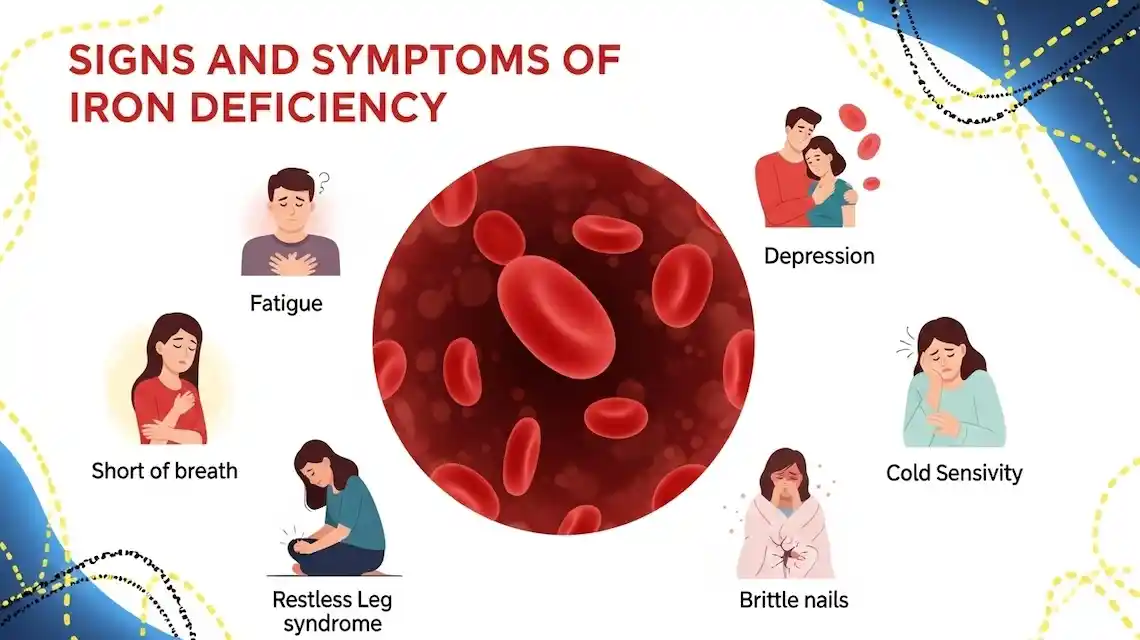
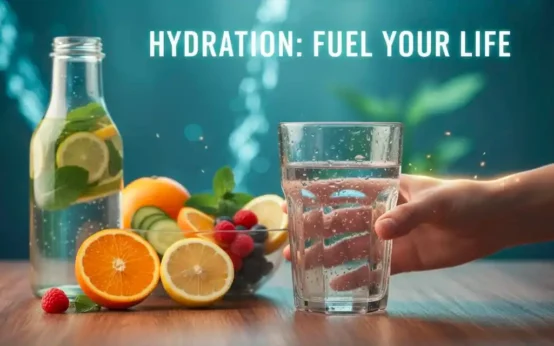 Importance of Hydration for Your Brain, Body, and Everyday Energy
Importance of Hydration for Your Brain, Body, and Everyday Energy 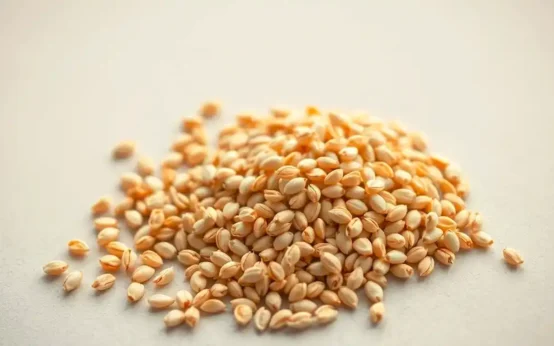 Health Benefit of Sesame Seed
Health Benefit of Sesame Seed 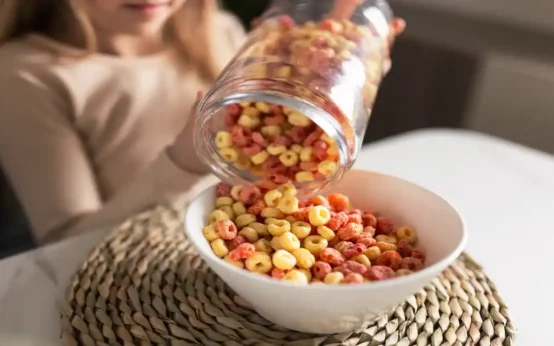 Healthiest Breakfast Cereal for Children
Healthiest Breakfast Cereal for Children  Anxiety Management Techniques
Anxiety Management Techniques  Vegan Oil Free Mayonnaise Recipe
Vegan Oil Free Mayonnaise Recipe 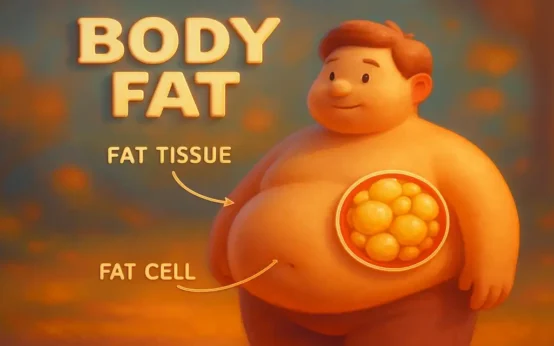 What Makes Fat in Our Body?
What Makes Fat in Our Body?